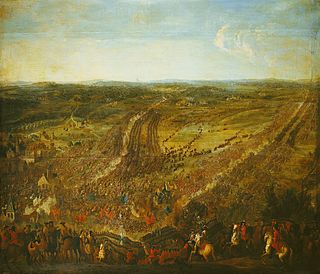
The Battle of Fleurus, fought on 1 July 1690 near Fleurus, then part of the Spanish Netherlands, now in modern Belgium, was a major engagement of the Nine Years' War. A French army led by Luxembourg defeated an Allied force under Waldeck.

The Battle of Denain was fought on 24 July 1712 as part of the War of the Spanish Succession. It resulted in a French victory, under Marshal Villars, against Dutch and Austrian forces, under Prince Eugene of Savoy.
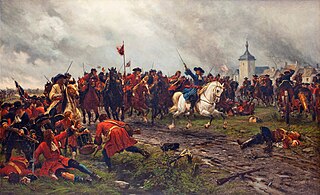
The Battle of Landen, took place on 29 July 1693, during the Nine Years' War near Landen, then in the Spanish Netherlands, now part of Belgium. A French army under Marshal Luxembourg defeated an Allied force led by William III.

The Battle of Oudenarde, also known as the Battle of Oudenaarde, was a major engagement of the War of the Spanish Succession, pitting a Grand Alliance force consisting of eighty thousand men under the command of the Duke of Marlborough and Prince Eugene of Savoy against a French force of eighty-five thousand men under the command of the Duc de Bourgogne and the Duc de Vendôme, the battle resulting in a great victory for the Grand Alliance. The battle was fought near the city of Oudenaarde, at the time part of the Spanish Netherlands, on 11 July 1708. With this victory, the Grand Alliance ensured the fall of various French territories, giving them a significant strategic and tactical advantage during this stage of the war. The battle was fought in the later years of the war, a conflict that had come about as a result of English, Dutch and Habsburg apprehension at the possibility of a Bourbon succeeding the deceased King of Spain, Charles II, and combining their two nations and empires into one.
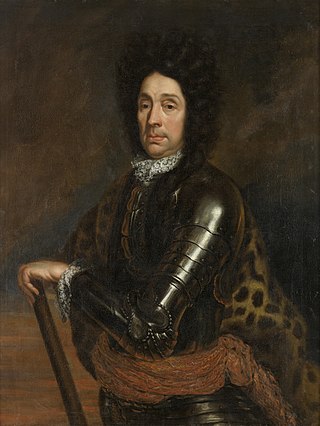
Menno, Baron van Coehoorn was a Dutch soldier and engineer, regarded as one of the most significant figures in Dutch military history. In an era when siege warfare dominated military campaigns, he and his French counterpart Vauban were the acknowledged experts in designing, taking and defending fortifications.

The 1695 Siege of Namur or Second Siege of Namur took place during the Nine Years' War between 2 July and 4 September 1695. Its capture by the French in the 1692 siege and recapture by the Grand Alliance in 1695 are often viewed as the defining events of the war; the second siege is considered to be William III's most significant military success during the war.

At the Battle of Elixheim, 18 July 1705, also known as the Passage of the Lines of Brabant during the War of the Spanish Succession, the Anglo-Dutch forces of the Grand Alliance, under the Duke of Marlborough, successfully broke through the French Lines of Brabant. These lines were an arc of defensive fieldworks stretching in a seventy-mile arc from Antwerp to Namur. Although the Allies were unable to bring about a decisive battle, the breaking and subsequent razing of the lines would prove critical to the Allied victory at Ramillies the next year.

The Battle of Ekeren, which took place on 30 June 1703, was a battle of the War of the Spanish Succession. A Bourbon army of around 24,000 men, conisting of troops from France, Spain and Cologne, surrounded a smaller Dutch force of 12,000 men, which however managed to break out and retire to safety.

General Jacob van Wassenaer Obdam was a Dutch general from the prominent Van Wassenaer family, who served in the Franco-Dutch War, Nine Years' War and War of the Spanish Succession. His extensive career made him eligible for the supreme command of the Dutch States Army in 1703, but his military career came to an abrupt end after he fled his army during the Battle of Ekeren and the position was given to Hendrik van Nassau-Ouwerkerk instead.

Frederik Johan van Baer, Lord of Slangenburg was a Dutch officer in the military service of the Dutch States Army. He served under William III of Orange in the Franco-Dutch War and Nine Years' War. He was to become a controversial figure for his role in the War of the Spanish Succession. While a talented general, he possessed a very difficult character. Slangenburg was often at odds with his fellow generals, especially the Allied commander-in-chief, the Duke of Marlborough. The hero status he acquired as a result of his conduct in the Battle of Ekeren couldn't prevent his eventual dismissal during the 1705 campaign. Leading writer Thomas Lediard to remark that Slangenburg: lost by his tongue what he had gained by his sword.

The siege of Lille was the salient operation of the 1708 campaign season during the War of the Spanish Succession. After an obstinate defence of 120 days, the French garrison surrendered the city and citadel of Lille, commanded by Marshal Boufflers, to the forces of the Duke of Marlborough and Prince Eugene.
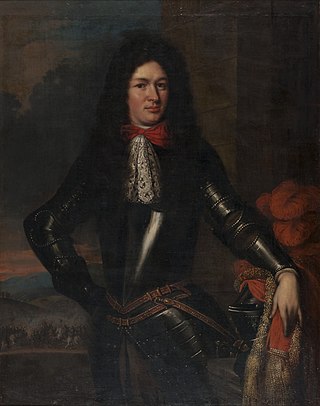
François Nicolas Baron Fagel was a talented infantry general serving the Dutch Republic. He was a nephew of Gaspar Fagel and took part in many battles during his career. He played an important role in battles such as the Battle of Landen, Battle of Ekeren and the Battle of Malplaquet, and In 1704 and 1705 he commanded the Allied forces in Portugal in collaboration with the Earl of Galway. He also was a siege expert and led the sieges of Béthune, Bouchain and Le Quesnoy in 1710, 1711 and 1712 respectively. He was the son of Nicolaas Fagel, mayor of Nijmegen, and Elisabeth Robbé.

The siege of Zoutleeuw or the siege of Léau was a siege of the War of the Spanish Succession. Allied troops with 16 artillery pieces under the command of the English Captain general the Duke of Marlborough, besieged and captured the small French-held Brabantine fortified town of Zoutleeuw in the Spanish Netherlands.

The 1694 Siege of Huy or Second Siege of Huy took place during the Nine Years' War between 22 September and 27 September 1694. The campaign of 1694 started rather late in the year. The French limited themselves to defending what they already had and William III first wanted to await the outcome of the expedition to Brest. The Anglo-Dutch amphibious assault was a failure. 2000 of the 7000 allies died in the assault. At the same time William III was gathering the Anglo-Dutch army at Leuven. At the end of July he reviewed the troops there and they were in excellent condition. The Anglo-Dutch army was reinforced by 6,000 Bavarian troops in pay of Spain and numbered 84,000 men in total. The allies possessed the numerical advantage so the French remained on the defensive. When this became clear to William III he sent the Duke of Holstein Plön and Menno van Coehoorn with an army to take the city of Huy. 5 days later on 27 September, the French garrison surrendered. The 780 remaining defenders of the original 1200 were allowed to march out with the honours of war. William III felt that enough had been achieved this year: He had caputured Diksmuide earlier that year and due to the capture of Huy the allies didn't have to keep as many troops on garrison duty in Liége and the Meuse was again in allied hands up to Namur. It also allowed him to plan for the siege of Namur the next year.

Claude Frederic t'Serclaes, Count of Tilly, was a prominent Walloon general in service of the Dutch States Army. He took part in the Franco-Dutch War, Nine Years' War and the War of the Spanish Succession and proved a brave and capable cavalry general. In 1708 he became the de facto supreme commander of the Dutch army, and led the Allied forces together with the Duke of Marlborough and Eugene of Savoy.

The assault on Nijmegen occurred during the War of the Spanish Succession, on 10 and 11 June 1702 involving French troops under the Duc de Boufflers against the small garrison and some citizens of the city of Nijmegen and an Anglo-Dutch army under the Earl of Athlone.

Frederick Christiaan van Reede, 2nd Earl of Athlone, baron of Ginkel and Agrim, lord of Amerongen, was a Dutch general and diplomat in the service of the Dutch Republic during the Nine Years' War and the War of the Spanish Succession.

Daniël Wolf baron van Dopff was a prominent soldier in the Dutch Republic. He was, among other things, general of the cavalry of the Dutch States Army in the War of the Spanish Succession, Quartermaster general of that army, and later commander and governor of the fortress of Maastricht.
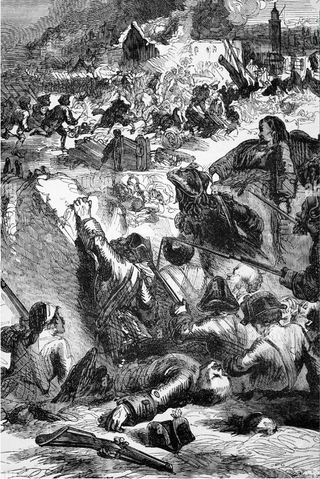
The Bombardment of Givet took place during the Nine Years' War on 16 March 1696. A Dutch army under Menno van Coehoorn and the Earl of Athlone closed in on the French town of Givet with the aim of destroying the supplies held there. In this way, they hoped that the French would not be able to mount an offensive that year. The action was a success and prevented the French from launching a major offensive.

The siege of Venlo was an 12-day siege of the city of Venlo commenced by the Grand Alliance which saw the city being taken after being occupied by French troops the year before. The siege of Venlo in 1702 was one of many sieges that Venlo had endured throughout its history.




















